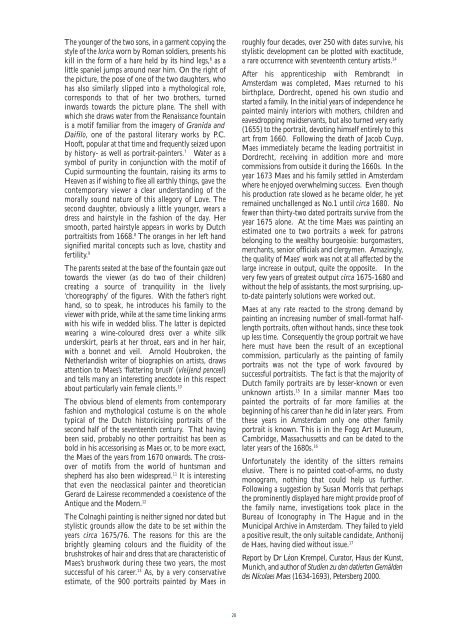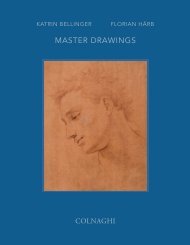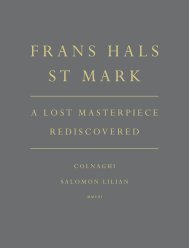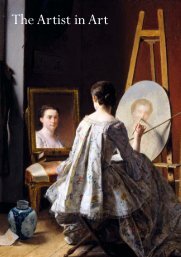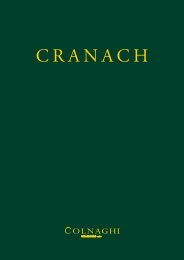2007 Catalogue - Colnaghi
2007 Catalogue - Colnaghi
2007 Catalogue - Colnaghi
You also want an ePaper? Increase the reach of your titles
YUMPU automatically turns print PDFs into web optimized ePapers that Google loves.
The younger of the two sons, in a garment copying the<br />
style of the lorica worn by Roman soldiers, presents his<br />
kill in the form of a hare held by its hind legs, 6 as a<br />
little spaniel jumps around near him. On the right of<br />
the picture, the pose of one of the two daughters, who<br />
has also similarly slipped into a mythological role,<br />
corresponds to that of her two brothers, turned<br />
inwards towards the picture plane. The shell with<br />
which she draws water from the Renaissance fountain<br />
is a motif familiar from the imagery of Granida and<br />
Daifilo, one of the pastoral literary works by P.C.<br />
Hooft, popular at that time and frequently seized upon<br />
by history- as well as portrait-painters. 7 Water as a<br />
symbol of purity in conjunction with the motif of<br />
Cupid surmounting the fountain, raising its arms to<br />
Heaven as if wishing to flee all earthly things, gave the<br />
contemporary viewer a clear understanding of the<br />
morally sound nature of this allegory of Love. The<br />
second daughter, obviously a little younger, wears a<br />
dress and hairstyle in the fashion of the day. Her<br />
smooth, parted hairstyle appears in works by Dutch<br />
portraitists from 1668. 8 The oranges in her left hand<br />
signified marital concepts such as love, chastity and<br />
fertility. 9<br />
The parents seated at the base of the fountain gaze out<br />
towards the viewer (as do two of their children)<br />
creating a source of tranquility in the lively<br />
‘choreography’ of the figures. With the father’s right<br />
hand, so to speak, he introduces his family to the<br />
viewer with pride, while at the same time linking arms<br />
with his wife in wedded bliss. The latter is depicted<br />
wearing a wine-coloured dress over a white silk<br />
underskirt, pearls at her throat, ears and in her hair,<br />
with a bonnet and veil. Arnold Houbroken, the<br />
Netherlandish writer of biographies on artists, draws<br />
attention to Maes’s ‘flattering brush’ (vleijend penceel)<br />
and tells many an interesting anecdote in this respect<br />
about particularly vain female clients. 10<br />
The obvious blend of elements from contemporary<br />
fashion and mythological costume is on the whole<br />
typical of the Dutch historicising portraits of the<br />
second half of the seventeenth century. That having<br />
been said, probably no other portraitist has been as<br />
bold in his accessorising as Maes or, to be more exact,<br />
the Maes of the years from 1670 onwards. The crossover<br />
of motifs from the world of huntsman and<br />
shepherd has also been widespread. 11 It is interesting<br />
that even the neoclassical painter and theoretician<br />
Gerard de Lairesse recommended a coexistence of the<br />
Antique and the Modern. 12<br />
The <strong>Colnaghi</strong> painting is neither signed nor dated but<br />
stylistic grounds allow the date to be set within the<br />
years circa 1675/76. The reasons for this are the<br />
brightly gleaming colours and the fluidity of the<br />
brushstrokes of hair and dress that are characteristic of<br />
Maes’s brushwork during these two years, the most<br />
successful of his career. 13 As, by a very conservative<br />
estimate, of the 900 portraits painted by Maes in<br />
28<br />
roughly four decades, over 250 with dates survive, his<br />
stylistic development can be plotted with exactitude,<br />
a rare occurrence with seventeenth century artists. 14<br />
After his apprenticeship with Rembrandt in<br />
Amsterdam was completed, Maes returned to his<br />
birthplace, Dordrecht, opened his own studio and<br />
started a family. In the initial years of independence he<br />
painted mainly interiors with mothers, children and<br />
eavesdropping maidservants, but also turned very early<br />
(1655) to the portrait, devoting himself entirely to this<br />
art from 1660. Following the death of Jacob Cuyp,<br />
Maes immediately became the leading portraitist in<br />
Dordrecht, receiving in addition more and more<br />
commissions from outside it during the 1660s. In the<br />
year 1673 Maes and his family settled in Amsterdam<br />
where he enjoyed overwhelming success. Even though<br />
his production rate slowed as he became older, he yet<br />
remained unchallenged as No.1 until circa 1680. No<br />
fewer than thirty-two dated portraits survive from the<br />
year 1675 alone. At the time Maes was painting an<br />
estimated one to two portraits a week for patrons<br />
belonging to the wealthy bourgeoisie: burgomasters,<br />
merchants, senior officials and clergymen. Amazingly,<br />
the quality of Maes’ work was not at all affected by the<br />
large increase in output, quite the opposite. In the<br />
very few years of greatest output circa 1675-1680 and<br />
without the help of assistants, the most surprising, upto-date<br />
painterly solutions were worked out.<br />
Maes at any rate reacted to the strong demand by<br />
painting an increasing number of small-format halflength<br />
portraits, often without hands, since these took<br />
up less time. Consequently the group portrait we have<br />
here must have been the result of an exceptional<br />
commission, particularly as the painting of family<br />
portraits was not the type of work favoured by<br />
successful portraitists. The fact is that the majority of<br />
Dutch family portraits are by lesser-known or even<br />
unknown artists. 15 In a similar manner Maes too<br />
painted the portraits of far more families at the<br />
beginning of his career than he did in later years. From<br />
these years in Amsterdam only one other family<br />
portrait is known. This is in the Fogg Art Museum,<br />
Cambridge, Massachussetts and can be dated to the<br />
later years of the 1680s. 16<br />
Unfortunately the identity of the sitters remains<br />
elusive. There is no painted coat-of-arms, no dusty<br />
monogram, nothing that could help us further.<br />
Following a suggestion by Susan Morris that perhaps<br />
the prominently displayed hare might provide proof of<br />
the family name, investigations took place in the<br />
Bureau of Iconography in The Hague and in the<br />
Municipal Archive in Amsterdam. They failed to yield<br />
a positive result, the only suitable candidate, Anthonij<br />
de Haes, having died without issue. 17<br />
Report by Dr Léon Krempel, Curator, Haus der Kunst,<br />
Munich, and author of Studien zu den datierten Gemälden<br />
des Nicolaes Maes (1634-1693), Petersberg 2000.


